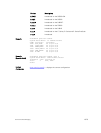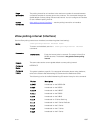
Version Description
9.4.(0.0) Added support for VRF.
9.0.2.0 Introduced on the S6000.
8.3.19.0 Introduced on the S4820T.
8.3.11.1 Introduced on the Z9000.
8.4.2.3 Added support for IPv6 sFlow collectors and agents on the
E-series TeraScale, C-Series, and S-Series.
8.4.1.1 Added support for IPv6 sFlow collectors and agents on the
E-series ExaScale.
8.3.7.0 Introduced on the S4810.
8.2.1.0 Introduced S-Series Stacking.
8.1.1.0 Introduced on the E-Series ExaScale.
7.7.1.0 Introduced on the S-Series.
7.6.1.0 Introduced on the C-Series.
6.5.1.0 Expanded the no form of the command to mirror the syntax
used to configure.
6.2.1.1 Introduced on the E-Series.
Usage
Information
You can configure up to two sFlow collectors (IPv4 or IPv6). If two collectors are
configured, traffic samples are sent to both.
The sFlow agent address is carried in a field in SFlow packets and is used by the
collector to identify the sFlow agent.
In sFlow, the agent address is a single invariant IPv4 or IPv6 address used to identify
the agent to the collector. It is usually assigned the address of a loopback interface
on the agent, which provides invariance. The agent address is carried as a field in
the payload of the sFlow packets.
As part of the sFlow-MIB, if the SNMP request originates from a configured
collector, Dell Networking OS returns the corresponding configured agent IP in the
MIB requests. Dell Networking OS checks to ensure that two entries are not
configured for the same collector IP with a different agent IP. Should that happen,
Dell Networking OS generates the following error: %Error: Different agent-
addr attempted for an existing collector
.
Example
Dell(conf)#sflow collector 10.1.1.25 agent-addr 10.1.1.10 vrf
management
1682
sFlow


















